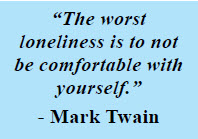Chronic Loneliness
 By: Lisa Philippart
By: Lisa Philippart
Loneliness is characterized by a state of enduring sadness that results from being alone. While loneliness is often associated with social isolation, an individual does not necessarily have to be socially isolated from others to feel alone. (For example, we can be connected with colleagues on a Zoom call and still feel lonely.) Loneliness is viewed as either situational or chronic. Situational loneliness is temporary and likely passes after a short period of time. This might include sadness that is a result of a loved one leaving home for a trip. The person left behind experiences melancholy that may linger for hours or days. Chronic loneliness (CL) is a persistent state of sadness that may last many weeks to months to indefinitely. The heartache one feels from the permanent loss of a loved one, including by death, is an example. The longer chronic loneliness persists, the more vulnerable one is to negative health effects. Common causes of CL include poor social connections and limited social support systems (think pandemic), decreased economic resources (ability to join clubs or organization), and changes in family systems (death of a loved one.)

While there is no formal DSM-5 diagnosis of chronic loneliness, this condition may be generally associated with depression. Symptoms of depression and chronic loneliness similarly include: little interest in doing things, feeling down, hopelessness, difficulty sleeping, fatigue, poor appetite, low self-esteem, and even suicidal thoughts. Obviously, higher levels of loneliness are associated with increased depressive symptoms. The DSM-5 characterizes depression by the presence of a sad, empty, or irritable mood accompanied by changes in both physical and cognitive abilities. Similar to the impact of depression, loneliness can affect overall cognitive and emotional functioning. The impact of CL on cognitive functioning includes impairment in attention, concentration, and memory abilities. When people experience significant depression or loneliness, they are likely to have difficulties paying attention to certain details, are prone to making errors or mistakes at work, and may have trouble recalling specific events or conversations. Emotionally, individuals who are chronically lonely may report feeling more moody, irritable, angry, impatient, and tearful. Unfortunately, CL can co-occur with, as well as exacerbate, other pre-existing mental conditions. Depression is a significant risk factor for suicidal behaviors. As such, socially disconnected and lonely individuals are at an increased risk of suicide.

Studies have suggested that both situational and chronic loneliness may be risk factors for mortality or death, although chronic loneliness presents a much higher risk. As mentioned above, CL is a risk factor for poor mental, emotional, and physical health. Depression and cardiovascular disease are the most studied health outcomes of CL. There has been some interesting research conducted on the gender-based impact of loneliness. Various studies indicate that men and women respond differently to social isolation and loneliness. For example, a study conducted by Dr. Anna Zebhauser entitled, “How Much Does It Hurt to Be Lonely?” identified that while loneliness affects both men and women, loneliness has a more harmful impact on men. Additionally, it was noted that loneliness affects the physical health of women more than men.

Some people suffer periodic episodes of loneliness that may be triggered by recent events, while others struggle with constant, unexplained loneliness. Chronic loneliness not only diminishes your sense of self-worth and self-confidence, but may also pave the way for heart problems and depression. Please do not dismiss your emotional health as unimportant, as it can significantly hamper your physical and mental health in the long run. In my next article, we will look at ways to prevent and treat chronic loneliness.
By: Lisa Philippart
Licensed Professional Counselor